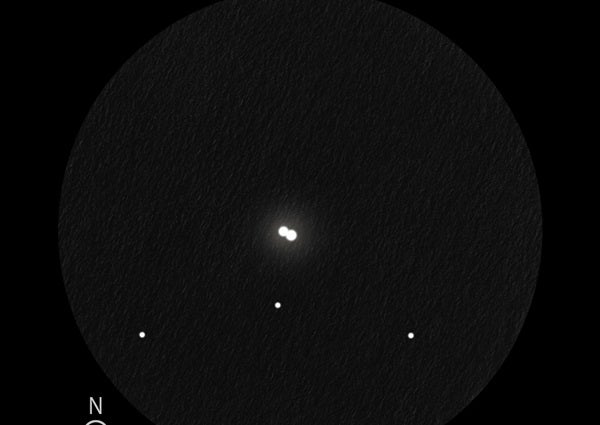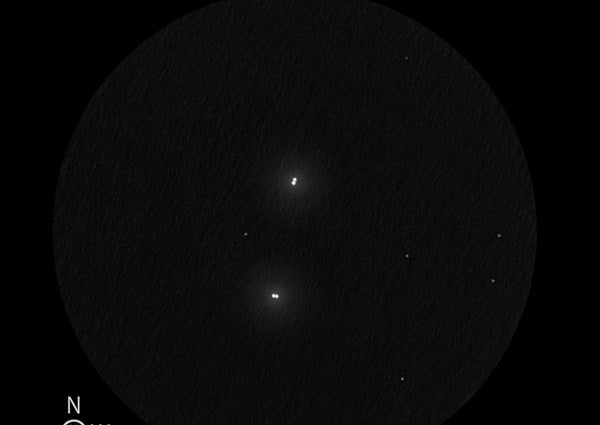One year ago, I introduced the double star marathon — a double star enthusiast’s answer to the annual Messier marathon. Nearly 70 of you requested the list, and two — Ben Rubel of Framingham, Massachusetts, and Jerry Oltion of Eugene, Oregon — captured all or most of them.
I wasn’t as successful. A week prior to the March 12–13 Messier marathon weekend, I did a trial run on the doubles hugging the western horizon after sunset. Starting at 7 p.m. with my trusty 10-inch reflector, I whipped through the soon-to-set doubles in Cassiopeia, Aries, Triangulum, Andromeda, Perseus, Pisces, and Eridanus. Once I completed the trial run, I couldn’t help but continue. (Once you’ve “tasted” one double star, you can’t stop.) I notched Polaris and then hit the doubles in Taurus and Orion. I then worked my way eastward, finally stopping at 9:50 p.m. with the pretty pair 54 Leonis. My final tally was 43 of the first 46. I missed three close pairs because of iffy seeing conditions.
I was primed for the main event when the bug hit — and it wasn’t the double star variety. A few days after my trial run, I came down with a nasty, lingering cold that sidelined me well into April. It denied me an opportunity to test the visibility of the double stars coming up in the east before dawn. My best take on the viability of my double star marathon list comes from the reports Rubel and Oltion sent me.
Rubel tackled the list on two fronts, using 4.5- and 8-inch scopes and a zoom eyepiece. “I did find it a bit easy for an 8-inch, and most of the stars were easy in the 4.5-inch,” he says. “I did the first half in close to the order on my sheet, and I jumped around more with the second half. In all I’d say I had about four hours of break time during the night, and that’s with using two telescopes for each star. The marathon helped my appreciation for double stars.”
This was the first astronomical all-nighter for the 16-year-old. His success with a 4.5-inch validated what I had hoped: The double star marathon can be completed with a small-aperture scope.
After being clouded out during a stay in Arizona, Oltion returned to his Oregon home, where he conducted the double star marathon over a two-night span using a 12.5-inch scope. “I got about 85 objects in one night, missing only the ones that were too far to the south for the site I was observing from and the ones that were too far east when the Moon rose, but I picked up the southerly ones the next night from a different site and wound up with 96 total over the two nights,” he writes. “The only reason I didn’t pick up all 110 was because I didn’t stay up all night either night.
“I didn’t find any doubles that I thought shouldn’t be on the list. There were a few tight ones and a few that were pretty low to the horizon, but the entire list is certainly doable from 44° north,” he adds. “The only suggestion I would make is to arrange them in the order that a person would most likely want to observe them, rather than strictly by R.A.”
Several of you asked if it would be appropriate to use go-to technology to track down the doubles. Why not? Because some go-tos identify double stars by their SAO number, California double star enthusiast Phil Kane took my list and added SAO designations. For a copy of his Excel file, contact Phil at icycomet1944@gmail.com.
This year’s Messier marathon occurs the weekend of March 25–26, so that’s when we’ll run the second double star marathon. Based on last year’s results, it seems the list doesn’t need much tweaking. I’m looking for reader help in checking the visibility of doubles setting in the west after sunset and those rising in the east before dawn. Kane recommends adding Psi1 (ψ1) Piscium (SAO 74482), which isn’t far from M74 and might be easier to spy in the twilight glow. As an upgrade to my list, which you can request through my email address, I’ve taken Oltion’s suggestion and added a section arranging the pairs in a practical observing sequence.
A final note: At the time of the Messier marathon, the Sun is in an area devoid of Messier objects. This is not the situation with double stars. Next September, I’ll look at some of the best pairs that can’t be seen during the double star marathon.
Questions, comments, or suggestions? Email me at gchaple@hotmail.com. Next month: When does one-quarter equal one-half?













